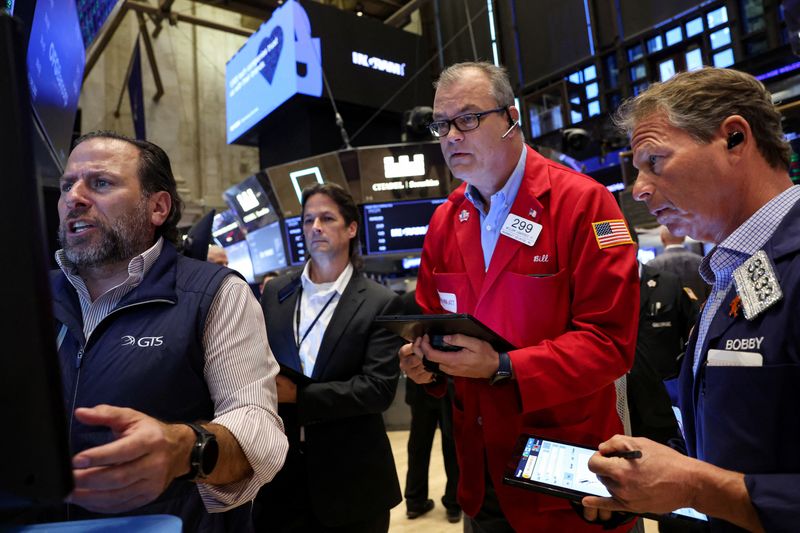In the upcoming week, the United States is poised to navigate two pivotal events that could significantly influence market dynamics: the presidential election and a crucial Federal Reserve monetary policy meeting. As citizens prepare to cast their votes on November 5, the election has already generated considerable excitement and volatility across financial markets. Central to these shifts is the erratic behavior surrounding the “Trump trade,” a term reflecting market movements tied to investor sentiment regarding Republican candidate Donald Trump’s perceived chances against Democrat Kamala Harris. Recent market trends indicate a strengthening U.S. dollar, a decline in Treasuries, and a surge in bitcoin, driven by anticipations that a Trump presidency may lead to more favorable regulations for the cryptocurrency sector, alongside positive economic indicators. Despite the apparent momentum for Trump, polls indicate a tight race, with investors bracing for potential turbulence regardless of the election’s outcome.
Market analysts express concerns regarding the volatility likely to unfold post-election. Walter Todd, chief investment officer at Greenwood Capital, notes that a victory for Trump could trigger a “sell the news” reaction, resulting in investors taking profits from Trump-related trades. Conversely, if Harris emerges victorious, the potential for a more profound market correction might occur. Beyond the presidential race, control of Congress, also determined by the election, adds another layer of complexity for investors, as differing economic policies proposed by the candidates could lead to divergent financial consequences. A Trump victory might result in reduced regulations benefiting banks and increasing volatility due to potential tariffs, while a Harris win could bolster the clean energy sector, impacting stocks related to renewable energy initiatives.
As uncertainty looms around the potential election outcomes, investors remain cautious about volatile scenarios, particularly if the election results are contested or delayed. The memory of the turmoil following the 2020 election, where Trump disputed the results and claimed widespread voter fraud, amplifies concerns around market stability. Despite the anxiety tied to the political landscape, some analysts assert that the stock market could thrive under either candidate’s administration if clarity regarding the election results soon emerges. Robert Pavlik of Dakota Wealth emphasizes that a transparent outcome is crucial for maintaining investor confidence, highlighting that markets have historically managed to adapt to both Republican and Democratic leadership.
Concurrently, the Federal Reserve’s monetary policy meeting scheduled for Thursday represents another crucial factor influencing market sentiment. The Fed’s decisions regarding interest rates could either underpin or undermine the recent rally in the S&P 500, which has seen significant gains year-to-date. Mixed earnings reports from several tech firms have contributed to a decline in the S&P index as of late October, making the Fed’s forthcoming decision even more pivotal. According to recent futures data, investors anticipate a modest rate cut of 25 basis points following the Fed’s first rate cut in four years during September. Market watchers are particularly interested in comments from Fed Chair Jerome Powell regarding future rate decisions and the potential for a pause in the cutting cycle, especially in light of robust economic data indicating growth, such as the solid 2.8% GDP growth rate for the third quarter.
The latest employment report, released shortly before the Fed meeting, adds another layer of complexity to the forecasts. While the overall economic growth appears strong, the report revealed nearly stagnant job growth for October, potentially influenced by various disruptions, including aerospace strikes and hurricanes impacting response rates in the payroll survey. JPMorgan economist Michael Feroli suggests that the nuances in the job growth data may still validate the rationale for a rate cut and that uncertainties surrounding both the economic outlook and election results necessitate a cautious tone in the Fed’s guidance going forward. This ongoing interplay between political developments and monetary policy will likely weigh heavily on investor sentiment in the forthcoming week.
In summary, the simultaneous events of the presidential election and the Federal Reserve’s interest rate policy review present a unique backdrop against which investors must navigate. With contrasting economic policies emerging from each presidential candidate and critical decisions from the Fed looming, market fluctuations are anticipated regardless of the results. Ensuring clarity in the electoral outcome is essential for stabilizing market sentiment, while the Fed’s approach to monetary policy in response to evolving economic conditions will play a vital role in shaping financial strategies in the near future. Ultimately, both the election and Fed meeting are set to create ripples throughout financial markets, influencing investment decisions and economic trajectories for weeks to come.

